I’m having another Wildlife Lover’s Moral Dilemma, but this time it’s of a different sort. Up until now, my love of butterfly caterpillars has known no bounds, and I’ve gone out of my way to plant larval host plants and create a Caterpillar Hotel and so forth. But today caterpillars have rained on my parade, and my beloved caterpillars have come back to bite me, or at least my precious flower favorites.
It’s been raining a lot lately, and so I’ve not been in the garden too much, grudgingly recognizing that the nutsedge and bermuda are taking over again in the meantime. But a glimpse out my bedroom window got me excited — blooms lower down on the tall Cinnamon Sunflowers meant I had a chance to take new photos of my dark red blooms. I rushed outside in a dry pause from the rain… to a horrible sight.
The first thing I saw from a mere glance was a mass congregation of black on the leaves of one of my yellow sunflowers. Caterpillars, and a lot of them.
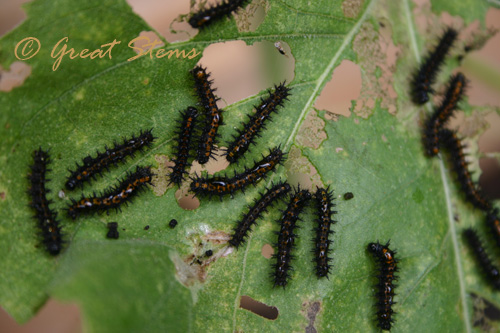 Then my eyes opened wider. There were more on the plant next to that one. And on down the short row.
Then my eyes opened wider. There were more on the plant next to that one. And on down the short row.
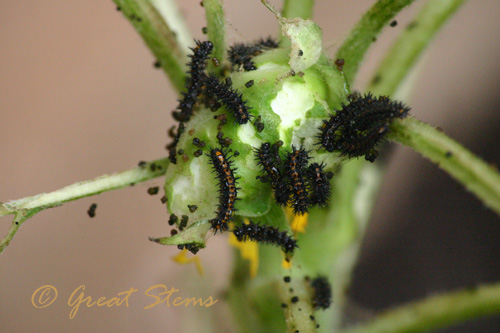 Then I was hit with the realization that they’d completely defoliated many of the leaves of the yellow sunflowers, to the point that I’m not sure whether there’s a future in sight for any of the already-struggling annuals.
Then I was hit with the realization that they’d completely defoliated many of the leaves of the yellow sunflowers, to the point that I’m not sure whether there’s a future in sight for any of the already-struggling annuals.
In fact, I’m quite certain that two of the smaller plants are dead, or at least zombies. I hadn’t even shown a photograph of a bloom from the poor traditional flowers — I’d been waiting for them to get bigger. I felt such sadness.
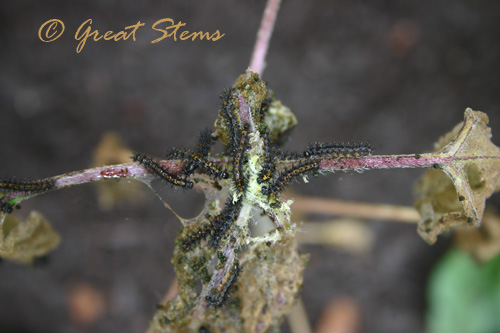
And then, like a scene in a horror movie, I turned slowly to look at my Cinnamon Sunflowers, dread gripping my heart.
The first thing I saw was caterpillar poop, and a lot of it.
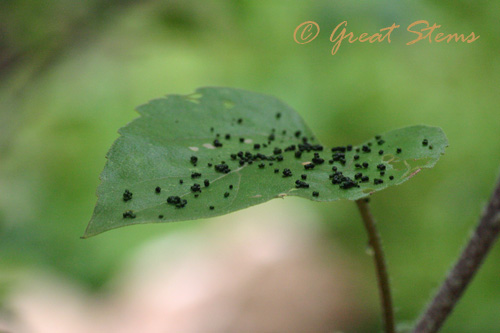
Ok, something’s eating my Cinnamon Sunflowers. Looks like a few caterpillars. At this point, I’m still thinking it’s ok — I knew the flowers were larval hosts. I accepted that.
But as I opened my eyes beyond the poop to the damage and destruction above, around, and beyond, my heart started breaking.
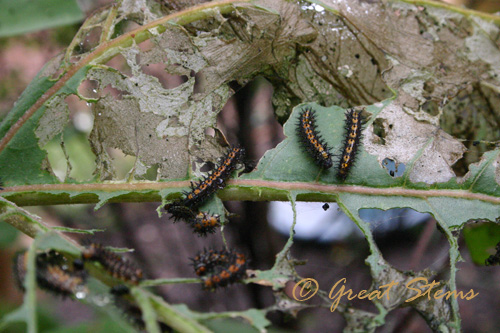
I have what I can’t seem to call anything else — an infestation — of literally hundreds of caterpillars of all sizes. I knew by the spines that there was a good chance they were butterfly caterpillars, but still… in those numbers?
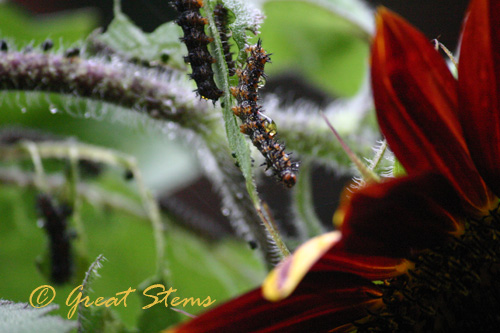 Part of me wanted them to be something that I could consider pest caterpillars, so that my moral dilemma could be simpler to deal with and I could find a soapy bucket of water. But no, as near as I can tell, these are the larvae of the Bordered Patch Butterfly. At some point, I am going to have incredible numbers of chrysalises and several dead, once beautiful sunflowers. Was this gorgeous butterfly from just a few weeks ago one of the culprits?
Part of me wanted them to be something that I could consider pest caterpillars, so that my moral dilemma could be simpler to deal with and I could find a soapy bucket of water. But no, as near as I can tell, these are the larvae of the Bordered Patch Butterfly. At some point, I am going to have incredible numbers of chrysalises and several dead, once beautiful sunflowers. Was this gorgeous butterfly from just a few weeks ago one of the culprits?
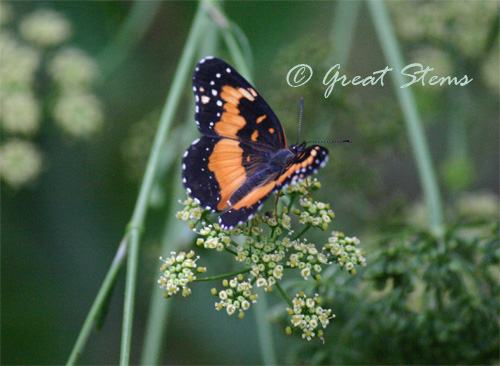
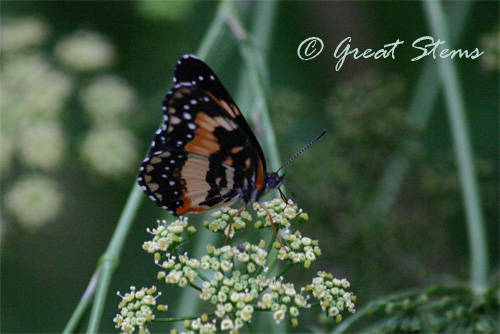 Despite the destruction, I can’t bring myself to dispose of the caterpillars, or feed them to the birds, nothing. Must… love… caterpillars.
Despite the destruction, I can’t bring myself to dispose of the caterpillars, or feed them to the birds, nothing. Must… love… caterpillars.
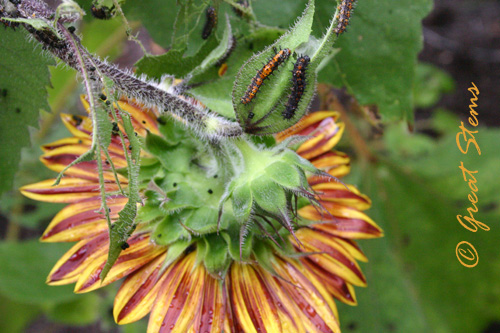 I can’t love the butterflies without supporting their eggs and babies. I guess I’m just going to have to watch them devour my plants and hope that the sunflowers, at least the larger ones, will recover.
I can’t love the butterflies without supporting their eggs and babies. I guess I’m just going to have to watch them devour my plants and hope that the sunflowers, at least the larger ones, will recover.
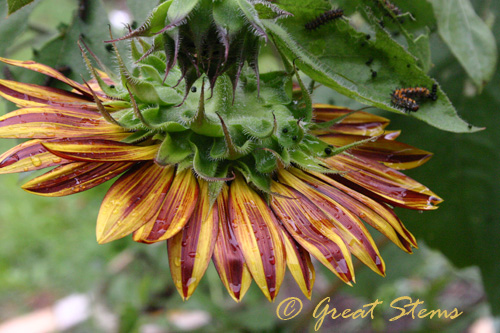 I thought about moving the Bordered Patch caterpillars over to the Zexmenia, also a host plant. But that’s when I discovered hundreds of caterpillars were over there, too. My beautiful Zexmenia, already getting eaten up, too. Gah! It’s ok, Meredith, it’s ok… planted as a host plant. All good.
I thought about moving the Bordered Patch caterpillars over to the Zexmenia, also a host plant. But that’s when I discovered hundreds of caterpillars were over there, too. My beautiful Zexmenia, already getting eaten up, too. Gah! It’s ok, Meredith, it’s ok… planted as a host plant. All good.
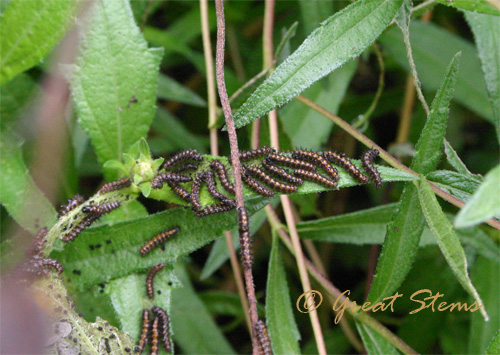
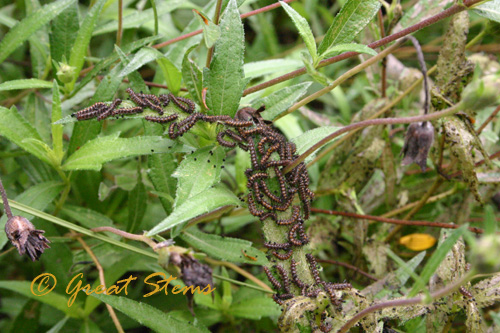 Here’s what I want to know: when exactly did these Bordered Patch butterflies show up laying eggs? And OH MY GOSH JUST HOW MANY EGGS CAN THEY LAY? Holy cow. And where are my beneficial predators now, now that I need some ecoystem balancing? Hello birds, stop feasting on my seeds and get yourself some live protein. Leave a few so there’s still a good population of butterflies, please. Why didn’t anyone tell me that Bordered Patch butterflies and their cousins are the rabbits of the butterfly world?!!!
Here’s what I want to know: when exactly did these Bordered Patch butterflies show up laying eggs? And OH MY GOSH JUST HOW MANY EGGS CAN THEY LAY? Holy cow. And where are my beneficial predators now, now that I need some ecoystem balancing? Hello birds, stop feasting on my seeds and get yourself some live protein. Leave a few so there’s still a good population of butterflies, please. Why didn’t anyone tell me that Bordered Patch butterflies and their cousins are the rabbits of the butterfly world?!!!
According to some sources online, Straggler’s Daisy, or Horseherb, is a larval host plant for the Bordered Patch. I’ve got plenty of horseherb, so I did try moving some of the caterpillars over. They wouldn’t eat while I was watching, and then the rain came again, so I’ll have to monitor them for awhile before moving the rest over. Cross your fingers — there’s a glimpse of hope for the sunflowers if I can pull this off. I’m not holding my breath for too long, though, since so many other sites didn’t list the little groundcover as a favorite host plant.
Between the masses of caterpillars eating my CinnSuns and the masses of nutsedge and weeds abounding in my garden, I just want to cry. And yet, I’m so happy we’ve had rain — just an absolutely wonderful thing in central Texas during the summer. And I can still smile at the Gulf Fritillary caterpillars on the passionvine.
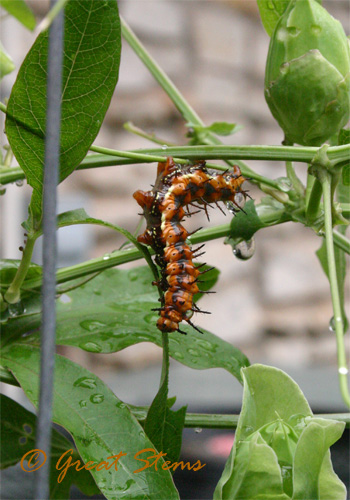 I saw one starting its chrysalis stage today — it’s a J right now — and I happily discovered a chrysalis hanging from a Mexican Redbud branch. (I also discovered a passionflower bloom in the redbud tree — that pesky vine has done it again!)
I saw one starting its chrysalis stage today — it’s a J right now — and I happily discovered a chrysalis hanging from a Mexican Redbud branch. (I also discovered a passionflower bloom in the redbud tree — that pesky vine has done it again!)
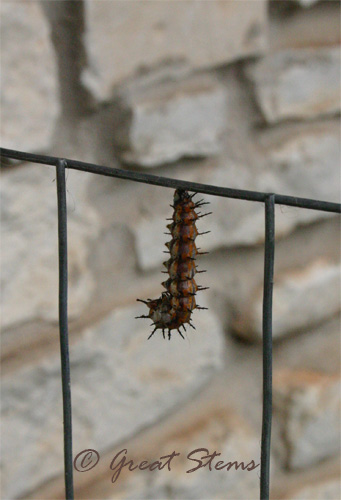
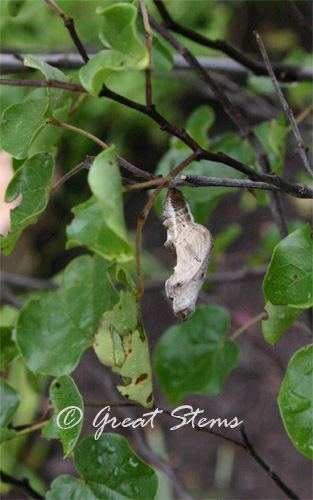 But overall I feel like I’m being tested, and I’m not sure whether I’m passing or failing. Passing as a wildlife lover with a high level of tolerance for munchers; passing as a butterfly grower. Failing as a gardener who wants beautiful, intact plants around; failing my new sunflowers. This isn’t my veggie garden– with my tomatoes, it was a war I had to engage in, those hornworms and stink bugs. Now the line in front of me is blurry. Should I be thinking of the crazy numbers of caterpillars as pests or be happy that I’m supporting more butterflies?
But overall I feel like I’m being tested, and I’m not sure whether I’m passing or failing. Passing as a wildlife lover with a high level of tolerance for munchers; passing as a butterfly grower. Failing as a gardener who wants beautiful, intact plants around; failing my new sunflowers. This isn’t my veggie garden– with my tomatoes, it was a war I had to engage in, those hornworms and stink bugs. Now the line in front of me is blurry. Should I be thinking of the crazy numbers of caterpillars as pests or be happy that I’m supporting more butterflies?
No worries, it’s still the latter. I just need to get used to this new concept of caterpillar quantity and re-evaluate my planting methods. Clearly I need more sunflowers so that my plants aren’t so easily overtaken. That will work, right? Learn to share, butterflies!
Hang in there, sunflowers. I know this is tough love from mama.
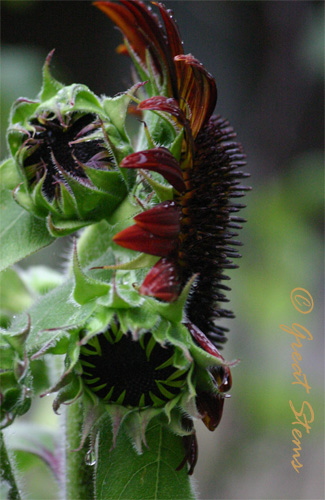
A smile from a damselfly to cheer us up… 🙂
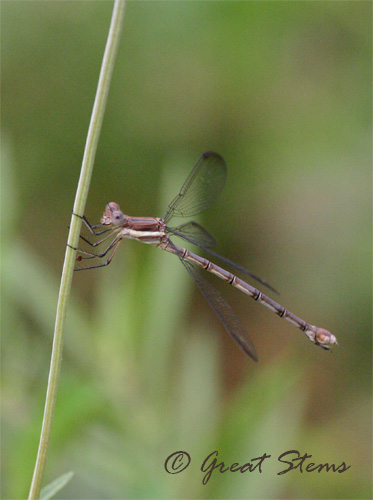
Bittersweet. That’s what it is. Bittersweet.
Even if they chew the heck out of your flowers… wasn’t it a great photo op? No really. I mean what better way to observe nature than to see them enjoying the fruits of your labor? I have these same feelings too when I see the chipmunks eating pansies etc. in my garden. It is a bittersweet thing, just as you stated.
Thanks for stopping by Dung Hoe, happy fourth to you!
Meredith,
Looks like you will have a lot of Bordered Patches! Have you made sure that is what they are? Only seen them a few times. Oh BTW the poop is called frass or fraz.
I always forget that word! I must work hard on remembering it. “Poop” is so much easier…
We hope something beautiful will appear from a flower, but we are presented with other beautiful things, butterflies. Both are beauties of nature……
have a nice day,
~bangchik
Meredith, that infestation looks quite horrific. I hope your big cinnamon survives the onslaught.
I’ve been watching like a hawk over my sunflowers and getting rid of any suspicious bugs. To my chagrin I just figured out that one of the persistent bugs that had taken residence and that I’d been harassing is actually an assassin bug (probably Zelus exsanguis). I now hope he’ll stick around and keeps on patrolling. Although I doubt he’d be any good against the hordes invading your plants.
Next door said go away, so they have all come to you. Where there is a Welcome/Habitat sign hanging on the gate! 😉 And the birds haven’t read the sign yet ;-(
I had the same sinking feeling last year with the passion vine (it was the first year I had planted it and it was pretty piddly. And then the fritillaries went and denuded it. twice. but the plant did come back this year, so I’ve been more lenient). When my caterpillar problems are at their worst, I will go out and scrape off eggs so I don’t have MORE caterpillars. I just feel so bad about killing caterpillars–even the ones that ARE considered garden pests.
I know. It’s a Catch 22 when the caterpillars you welcome out-eat the plants you have. But most plants do grow back — the pipevine, the passionflowers, and so forth. And I’ll keep growing sunflowers — I just will feel better about having lots of them around.
These caterpillars started in on my sunflowers a couple of weeks ago, and if it goes like mine, you’ll end up with dozens of butterflies from their buffet (they do indeed look like Bordered Patches).
It’s kind of amazing walking through the skeletal remains of sunflower leaves and having all that color take wing. Many of my sunflowers still make it to seed and feed the birds, too.
Only one thing to do — plant more sunflowers! I suppose ‘problems’ like this are the difference between having a garden and a wildlife habitat. As my husband constantly reminds me when I want to ‘fix’ such ‘problems’ — “It’s nature. Let it be.”
Thanks a bunch, Meredith – my 3 native annual sunflowers were being devoured so I came in to search for the identity of caterpillars on sunflowers… when your blog came up I was sure you had it right.
The main reason I let a couple of these gawky giants seed is for the birds, but the dozen Bordered Patch butterflies now flitting around are awfully pretty. Think I’ll clip the eggs and caterpillars off two of the plants and sacrifice the third. Maybe if I put the clippings in a big saucer near a birdbath the birds will eat them.
Annie at the Transplantable Rose
I’m glad you have lots of Bordered Patch butterflies now! I never knew their habits prior to the Sunflower Incident, but it has definitely been an education.
these showed up on my sunflowers today. First time seeing them. Planted sunflowers last year because my son wanted to and they were beautiful. Even got a red one. So we planted again. I was very scared when I saw these today. Posted a picture on FB and a friend led me to this blog. So glad she did because we were about to destroy them. I will now let them be. I was worried they were going to get to my vegetables but it sounds like they just like the sunflowers.
Yep, Rene — they love (and need) their sunflowers and certain related asters, but they’ll leave your veggies alone.
I was amazed to see a tall sunflower plant spring up after the rains here in texas. Went to enjoy the sunflowers upclose today and got the caterpillar suprise. Tons of them, completely eating away the sunflowers. Next to sunflowers are my rose bushes, which so far the caterpillars have left alone. Am I safe just to leave them and let them become butterflies? Or should I relocate the whole sunflower plant? so glad i came across your blog. Thanks for any info!
Those caterpillars, as you likely discovered, are sunflower consumers and don’t have interest in rose plants. So I suspect your roses were safe! Happy to hear that you are supporting wildlife!
I had the same thing happen to my sunflowers in west Texas (near Lubbock) this year. First time ever in my 5+ years of growing sunflowers yearly.
I googled it and came across this post. I’m happy to see that they will be butterflies. When I first noticed them, my cure was to pull and trash the infected plants. I gave up after I figured out the battle was not mine to win.
Thankfully, my sunflowers were of such age that they bloomed and produced seeds per usual, even of they did look a little odd with the skeleton leaves.
I was leaning towards harvesting and cutting down the stalks, as they’re about ready, but I think I’ll leave them this year and deal with the ugliness so that I can enjoy the butterflies later.
And the seeds from the sunflowers can still provide for birds — I’m glad you kept them!